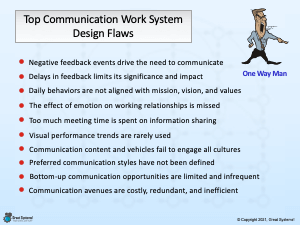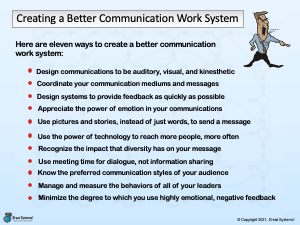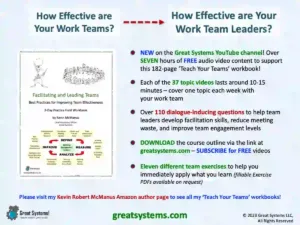Measure and Improve Your Communication Work System
If I had to pick one thing to teach people about communication, I think I would have to select the concept of communication style. I first came across the concept of neurolinguistic programming over 30 years ago. Then, it was presented more as a tool for manipulating others.
As I learned more about it, and thought about its implications in our organizations, I saw other possible uses for the tool. How do you measure and improve your communication work system?
In short, people have preferences in terms of how they send and receive information. The majority of the population is visual – they like to see pictures and use pictures to describe their message. The auditory communication medium comes in a close second. Kinesthetic communicators however tend to make up only 10-15% of the population. On the front lines of our workplaces however, we tend to have many more people who communicate by doing or touching.
In order to succeed in our formal education system, you have to have visual and auditory communication preferences. If you don’t, you might do well in shop, art class, or gym, but you will struggle in a lecture-based classroom.
In our culture, the visual and auditory people become managers, and the kinesthetic people work on the front lines. The foundation is thus laid for significant communication failures.

Why Do Our Communication Work Systems Fail?
We tend to teach others as we have been taught. We try to send our messages to others in the styles we personally tend to prefer, which is usually visual and auditory. If a high percentage of our hourly workforce in particular is kinesthetic however, they may not be ‘listening’ to our messages.
Emotion further complicates the communication issue. If we send a message that one perceives as negative, our listeners shut down. Their brains won’t allow that type of stuff into their memory banks.
Failures to appreciate diversity also trigger a negative, message-altering reaction. To make matters worse, we all perceive things differently in general. Words mean different things to different people.
You can’t construct and deliver a perfect message. You can take steps to increase the odds that your message gets through. What types of messages do you send? How often do your messages get through?
The Daily Communication Log In
Twenty years ago, we had to rely primarily on bulletin board postings, flyers in mailboxes, break room gossip, and face-to-face meetings to send and receive messages in our organizations. With the advent of the internet, intranets, e-mail, and social media, things are different now.
Now, the communication pendulum seems to be moving in the extreme opposite direction. If you don’t have a Facebook or Twitter account, you might not have much of a voice or be very well-informed.
It is true that texts, social media, and e-mail provide a much easier means to send and receive messages. This is especially true when the message goes out to a large group of people. However, I think people learn to hide behind their messages and screens. When we only comment to a screen, we can be more bold, express different emotions, and even say things that we might not have said in person.
This shift will correct itself in time. I look forward to the time when it does. A company intranet offers a lot of promise in terms of reaching our people and letting them reach back. Some companies recognize this already.
They provide each employee with an e-mail address and send a majority of their information out via this medium. Some go as far as to survey their people regularly through the use of pop-ups that appear when each employee logs in each day. How do you use today’s technology to communicate?
What are Your Communication Work System Costs?
I look at communication costs from two perspectives. First, what does it cost to deliver key communication to your people? Second, how much money do you waste in attempts to communicate with people in your organization?
The first cost total is easier to arrive at than the second one is. In the past, non-labor communication costs were paper, travel, and phone line-based. Now, we use much less paper (unless you are one of those people who still print out each of their e-mails) and travel, and much more wireless communication.
The labor costs could be considered to be any time we spend with other people or we spend reading or writing messages. When you look at it from that perspective, communication costs represent a high percentage of the cost in most products and services. Needless to say, communication, and the ability to do it well, is very important. That’s where the waste perspective comes in.
One of the more common ‘areas of improvement’ that you will find at the top of the list on most attitude surveys is ‘we need better and more communication.’ Have you heard people express such sentiment in your organization?
If that area of improvement heads many such lists, then there must be some waste lurking behind those concerns. Why don’t we communicate more effectively?
Where are Our Communication Waste Streams?
To look at communication cost and waste further, let’s refer back to the pie chart that most of us have seen as to how people really communicate messages. The percentages go something like this – 7% of the message comes from the words we say.
Around 35% of the message is communicated by our voice tone and its inflections. The remaining 58% of the message is conveyed by our physiology. What degree of potential message interpretation errors exist given these percentages? How many millions of body language books have been sold?
To make matters worse, communication is a two way street. Communication involves both a sender and a receiver, and both can misunderstand or mistranslate a message.
Our workplaces continue to grow more diverse. This alone increases the potential for diversity-based communication waste. Different cultures see (and hear and read) things differently. I am confident this trend continues in the current direction.
I may not be able to put a dollar value on communication costs, but I can say with a lot of confidence that there is a lot of waste in our communication systems. If words only convey 7% or our message and we are using e-mail more and more (which is a words only medium), we are creating more and more waste by the minute!
There is a way out. We can improve our communication systems. Event time can be used more wisely. We can better manage the different communication avenues that we use. Most importantly, we must each learn to appreciate the perceptual differences that we each have, and structure our messages accordingly.
LEARN MORE: Check out my Facilitating and Leading Teams workbook
How to Improve Your Communication Work System

Do You Need to Measure and Improve Your Communication Work System?
For over 40 years, I have helped people improve their communication work systems in many different companies and in a variety of business arenas. Plus, I have discovered value added, simple ways to help improve how we send and receive messages in our organizations.
Relying on one way, infrequent, and often negative communication approaches is the primary power restrictor for a communication work system. When you redesign your communication work system, it helps you better resolve such issues on a daily basis. Done properly, these changes significantly reduce the communication costs you currently invest.
If you don’t want to go after the big work systems change, you can work with me to install an effective event management process. This process will help you get the most out of the variety of meetings and training events that you spend a lot of money to have. How much meeting and training waste exists in your organization?
Keep improving!
Kevin McManus, Chief Excellence Officer, Great Systems
WATCH over 50 kaizen and workplace health improvement videos on my Great Systems YouTube channel.
CHECK OUT my ‘Teach Your Teams’ workbooks on Amazon.com
LIKE Great Systems on Facebook
© Copyright 2024, Great Systems LLC, All Rights Reserved




